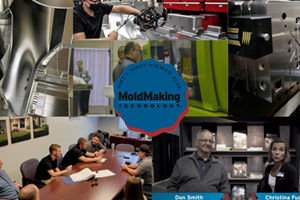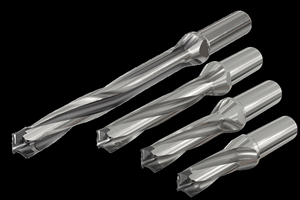The Addition of Subtraction
Milling is once again a valued rapid prototyping solution because of new subtractive rapid prototyping (SRP) technologies.
It is little wonder why so many design engineers have ignored CNC machines for their prototyping needs. With so many impressive additive rapid prototyping (ARP) technologies available, design engineers can give shape to everything from concept models to large investment casting patterns. They have had no reason to trouble themselves with large and expensive CNC machines that sit on the manufacturing floor and use cryptic G-code.
However, because of new subtractive rapid prototyping (SRP) technologies, milling is once again a valued RP solution. According to Terry Wohler's 2002 Report on Rapid Prototyping & Tooling State of the Industry, engineers and product designers purchased more SRP devices last year than the top two ARP devices combined.
Of course, we are not talking about traditional CNC mills. These benchtop SRP milling devices are small, inexpensive and easy to use; yet, they have the power to turn out prototypes of almost any material with better speed and precision than any ARP system. When it comes to producing manufacturable prototypes, SRP devices have found their niche. In fact, the mere act of milling actually verifies a part's manufacturability.
"SRP systems have become so sophisticated, engineers now need to understand when the best time is to use which RP technology," says Boris Fritz, chairman of the SME RP Association. "SRP, for example, is great for testing because you can mill the final material."
The four leading RP technologies are SRP, SL, 3-D printing and Fused Deposition ModelingT (FDM). With a unique set of pros and cons, each one is best suited for specific RP applications (see Table 1).
Table 1: Leading RP technologies rated on the four-star system. (x = one star)
| Technology | SL | FDM | 3-D Printing | SRP |
| Maximum Part Size | 20" x 20" x 24" | 24" x 20" x 24" | 20" x 24" x 16" | 25" x 17" x 6" |
| Joining | xxx | xxx | xx | xxxx |
| Complex Shapes | xxxx | xxxx | xxxx | xx |
| Accuracy | xxx | xx | xx | xxxx |
| Surface Finish | xxx | xx | xx | xxxx |
| Material Available | xx | xxx | xx | xxxx |
| Strengths | Market Leader, Large Part Size, Accuracy, Wide Product Line | Office OK, Price, Materials | Speed, Office OK, Price, Color | Speed, Office OK, Price, Unlimited Materials, Finish, Verifies Manufacturability |
| Weakness | Post Processing, Messy Liquids | Speed | Limited Materials, Fragile Parts, Finish | Difficulty with Deep Undercuts |
| System Price | $75-800K | $30-300K | $30-70K | $3-24K |
Subtractive Rapid Prototyping
Although they have trouble milling prototypes with complex geometries and deep undercuts, benchtop SRP devices are extremely good at cranking out precision prototypes that are manufacturable every time. Using a wide variety of inexpensive materials, including polyurethane, resin, ABS, aluminum and brass, SRP devices mill prototypes that take less time and money to produce. When the prototype is done, it requires no hand finishing.
The lower initial equipment costs let designers create prototypes in-house. Engineers can produce prototypes in hours that normally take days to get back from a service bureau. In this way, SRP technology helps protect proprietary secrets and provides greater control over the design process.
In addition, manufacturers have optimized today's SRP devices specially for RP. For example, some SRP devices mill a wide range of materials without gumming up the liquid coolant systems found on traditional CNC production mills. These devices also have no requirement for three-phase power, allowing design engineers turn out prototypes right in their offices. At the same time, these SRP devices still offer the power and precision associated with AC servomotors, look-ahead processing, simultaneous fourth-axis controls and automatic tool changers.
Finally, manufacturers also have solved SRP's age-old problem with ease of use. Some, for example, offer easy-to-use, seamless functionality between SRP devices and popular CAM software. Such interoperability is bringing machining technology from the shop floor into the design environment.
Stereolithography
SL is a favorite in the aerospace industry for creating complex prototypes with fine detail. "The most common application is producing wind tunnel models," explains Fritz, who also is a senior technical specialist at Northrop Grumman (El Segundo, CA)-a global defense company. "SL is perfect because airplane parts, such as intake manifolds, can be incredibly complicated structures."
By tracing a laser beam on the surface of a vat of liquid photopolymer, Fritz builds plastic parts one layer at a time. The material quickly solidifies wherever the laser beam strikes the surface. After each layer is completely traced, he lowers the part a small distance into the vat and a second layer is traced right on top of the first. The self-adhesive property of the material causes the layers to form a complete, 3-D object. "Not a big deal," says Fritz. "You just throw in the part and it's done in a matter of hours."
Some parts have overhangs or undercuts that must have support from structures designed and fabricated right along with the object. On completion of the fabrication process, the object is elevated from the vat. Design engineers must then cut off the supports and sand the surface until it is smooth.
3-D Printing
Three-dimensional printing quickly creates excellent visual concept models. This technology digitally slices a 3-D model into hundreds of cross-sections. Then, it prints each section using a starch/sugar powder and a binding chemical, piling the layers atop one another until the object takes shape. Powder also is laid down around the model to support it. But because it is not chemically treated, it falls away and can be recycled.
These prototypes are perfect for evaluating design, form, shape and even color. Three-dimensional printing provides design engineers with a relatively easy and cost-effective means to touch, feel or grasp the information on their computer screen. From teapots to PDAs, this technology helps a wide variety of products come to market quicker.
On the downside, 3-D printing often yields prototypes that are brittle and grainy. The surface finish, although it has improved in recent years, still leaves much to be desired. For a smooth surface, design engineers still must sand these parts by hand.
Fused Deposition ModelingT
FDM produces small, durable parts. It uses a wide range of thermal plastic materials and is ideal for creating ABS prototypes for durable, handheld components such as drill handles.
"The new polycarbonate material is incredibly tough," says Fritz. "At last year's Rapid Prototyping & Manufacturing show, we tested it by smacking a golf ball prototype. We're actually looking into using it as an end product for aerospace applications."
Watching a FDM machine run is like watching a fine hot glue gun attached to a vector-based 2-D plotter. A plastic filament is unwound from a coil and supplies material to an extrusion nozzle. The engineer must heat the nozzle to melt the plastic and control the flow of the melted plastic. The nozzle moves over the table in the required geometry and deposits a thin bead of extruded plastic to form each layer. The plastic hardens immediately and bonds to the layer below. The entire system is contained within a chamber that is just below the melting point of the plastic.
Although they have improved in recent years, surface finish and accuracy are not among the strong points of FDM. Both surface finish and accuracy rate are lower than SL and SRP methods.
Available materials for the process include ABS and investment casting wax. ABS offers good strength, and, more recently, polycarbonate and polysulfone materials have been introduced, which extend the capabilities of the method further in terms of strength and temperature range. For overhanging geometries, engineers can fabricate support structures and break them away from the object later. They also can wash away an available water-soluble support material.
The Right Tool for the Job
The bottom line is simple. If you want to create prototypes that work, use the right tool for the job. Different RP systems yield prototypes best suited for different applications. Selecting the right one will help you save time and money and achieve better results. SRP offers a great way to create manufacturable prototypes quickly, precisely and inexpensively; SL is excellent for making complex prototypes with fine detail; 3-D printing quickly turns out visual concept models of almost any shape imaginable, and FDM technology specializes in building small, durable parts.
| Johnson & Johnson Puts Function Before Form |
| Using SRP technology, Johnson & Johnson (New Brunswick, NJ)-a health care products company-creates functional toothbrush prototypes. Design engineers mill them from actual toothbrush plastic, making it possible to evaluate characteristics early in the design process.
Because the finished prototype is a working model, Johnson & Johnson can run tests on it to work out any potential design problems. In-vitro tests reveal everything from product wear and fatigue to fit and aesthetics. After that, focus groups and observed consumers actually use the prototypes. If a prototype fails at any point during testing, the design goes right back into the CAD software program for re-editing. In some cases, the product must go back to the drawing board for the industrial designer to create a new model. "The SRP device accepts so many materials that we can test for FDA consumer guidelines and evaluate different types of materials/plastics for usability before any production begins," says Justin McDonough, Johnson & Johnson product designer. Evaluating functional prototypes in the design stage lets Johnson & Johnson get products to market faster and decrease development costs. Correcting problems after production begins is much more cumbersome and expensive. The Workflow Then, Johnson & Johnson quickly cranks out a functional prototype in just a few hours. After generating accurate toolpaths with SDRC IDEAS CAM software, they simply set up the SRP milling device with the proper tools and begin milling. "The SRP process forces due diligence," says McDonough. "Parting lines, undercuts, feature details and part thickness are all part of the preparation. Depending on part complexity, the process is easy, but we mostly appreciate how it limits the number of design changes." SRP Advantages Engineers also can choose between several CAM software packages for producing required SRP postprocessing code. These applications make it easy to use native CAD geometry without having to go through an IGES, STEP or .stl translator. "SRP technology has been around for a long time, allowing optimization of tools and procedures," says McDonough. "This minimizes potential bugs and large hidden costs, such as maintenance, which is frequently costly or not available from ARP manufacturers." |
Related Content
Most-Viewed Content of 2022
The most popular MoldMaking Technology content according to analytics reports over the past 12 months.
Read More6 Ways to Optimize High-Feed Milling
High-feed milling can significantly outweigh potential reliability challenges. Consider these six strategies in order to make high-feed milling successful for your business.
Read MoreModular Tooling Systems Enable Versatility in Hole-Drilling Operations
The versatility of replaceable cutting edges offers users the ability to adapt to varied operations.
Read MoreRead Next
Are You a Moldmaker Considering 3D Printing? Consider the 3D Printing Workshop at NPE2024
Presentations will cover 3D printing for mold tooling, material innovation, product development, bridge production and full-scale, high-volume additive manufacturing.
Read MoreReasons to Use Fiber Lasers for Mold Cleaning
Fiber lasers offer a simplicity, speed, control and portability, minimizing mold cleaning risks.
Read More





_300x250 3.png;maxWidth=300;quality=90)

.png;maxWidth=300;quality=90)











.jpg;maxWidth=300;quality=90)







